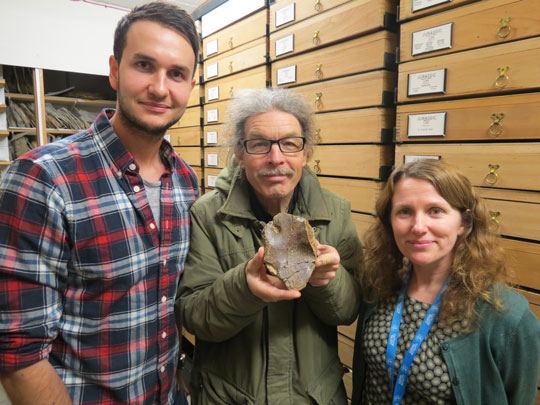Rare Ichthyosaur Specimen Only the Second to be Described
Second Specimen of Wahlisaurus massarae to be Described
A rare 200 million-year-old specimen of a “fish lizard” has been discovered in a private collection twenty-two years after it was originally found. The fossil is only the second example of Wahlisaurus massarae, a species of ichthyosaur, to have been described. The new species was established in 2016, by University of Manchester palaeontologist, Dean Lomax following his detailed assessment of a fossil specimen that had been found in Nottinghamshire many decades ago.
Wahlisaurus massarae
An Illustration of Wahlisaurus massarae
Picture credit: James McKay
To read Everything Dinosaur’s 2016 article on the discovery of W. massarae: New Species of British Marine Reptile Surfaces.
This second example of Wahlisaurus was originally found in 1996. It has now been donated to the Bristol Museum and Art Gallery, an institution that houses several examples of marine reptiles, including a specimen of Excalibosaurus, which, until the naming of Wahlisaurus two years ago had been the most recent species of ichthyosaur from the British Isles to have been scientifically described.
Ichthyosaurs in the Limelight
The Ichthyosauria clade has been much in the news of late. For example, earlier this month the discovery of a large ichthyosaur fossil in the cliffs close to Lyme Regis in Dorset, was the subject of a BBC television documentary, narrated by Sir David Attenborough.
To read Everything Dinosaur’s article on “Attenborough and the Sea Dragon”: Attenborough and the Sea Dragon (BBC).
Dean Lomax named W. massarae in honour of two vertebrate palaeontologists who had spent much of their lives studying marine reptiles (Professor Judy Massare and Bill Wahl).
Dean commented:
“When Wahlisaurus was announced, I was a little nervous about what other palaeontologists would make of it, considering the new species was known only from a single specimen. As a scientist you learn to question almost everything and be as critical as you can be. My analysis suggested it was something new, but some palaeontologists questioned this and said it was just variation of an existing species.”
Visit the website of Dr Dean Lomax: British Palaeontologist Dr Dean Lomax.
Clues in the Shape of the Coracoid Bone
In this new research, Dean teamed up with Dr Mark Evans, palaeontologist and curator at the New Walk Museum, Leicester, and fossil collector, Simon Carpenter from Somerset. The study focused on a specimen Dean identified in Simon’s personal collection, which is an almost complete coracoid bone (part of the shoulder girdle, otherwise referred to as the pectoral girdle). This bone had exactly the same unique features of the equivalent bone in the holotype of Wahlisaurus described in 2016. Simon’s fossil specimen was originally collected twenty years ago, from a quarry in northern Somerset. Once the specimen’s rarity was realised, Simon immediately donated it to Bristol Museum and Art Gallery.
Dean Lomax, Simon Carpenter and Deborah Hutchinson with the Coracoid Specimen

Picture credit: Manchester University
Dean added:
“You can only imagine my sheer excitement to find a specimen of Wahlisaurus in Simon’s collection. It was such a wonderful moment. When you have just one specimen, “variation” can be called upon, but when you double the number of specimens you have it gives even more credibility to your research.”
The new discovery is from a time known as the Triassic-Jurassic boundary, right after a world-wide mass extinction. For these reasons, the team have been unable to determine exactly whether the ichthyosaur was Late Triassic or Early Jurassic in age, although it is roughly 200 million-years-old.
A Better Understanding of the Skull Structure
As part of the research, Dr Evans cleaned the bones and removed additional rock from the first specimen. This assisted in a detailed re-examination of the original skull, which led to the discovery of additional bones helping scientists to better understand the morphology of the skull of this British marine reptile.
Finding evidence to help confirm the validity of a genus within a private fossil collection helps to demonstrate the important contribution that can be made to science by dedicated and responsible fossil collectors.
The scientific paper: “An Ichthyosaur from the UK Triassic–Jurassic boundary: A second specimen of the Leptonectid Ichthyosaur Wahlisaurus massarae Lomax 2016” by Lomax, D. R., Evans, M. and Carpenter S., published in the Geological Journal.
For models and replicas of ichthyosaurs and other marine reptile figures: Prehistoric Animal Models and Figures Including Marine Reptiles.


